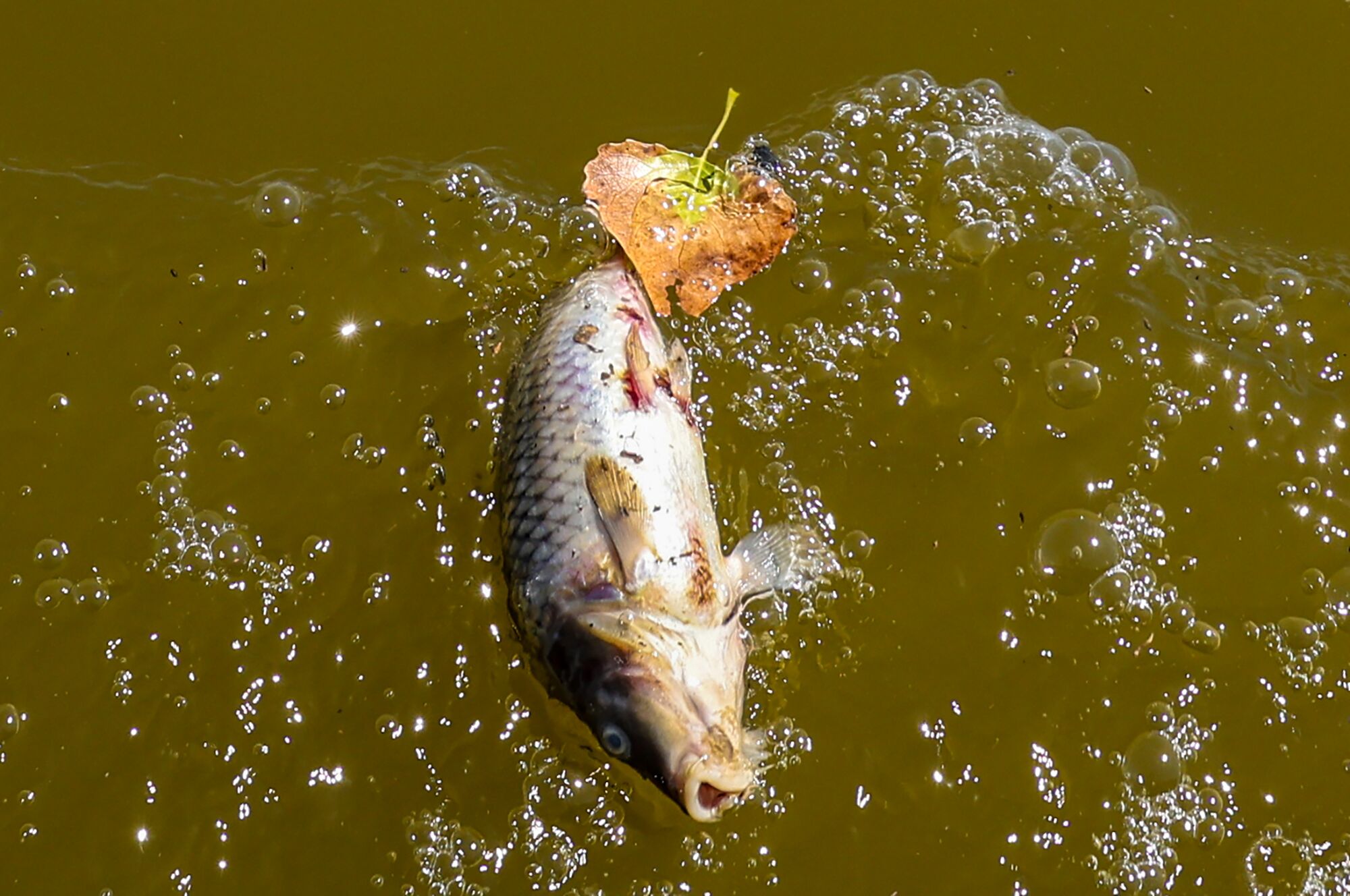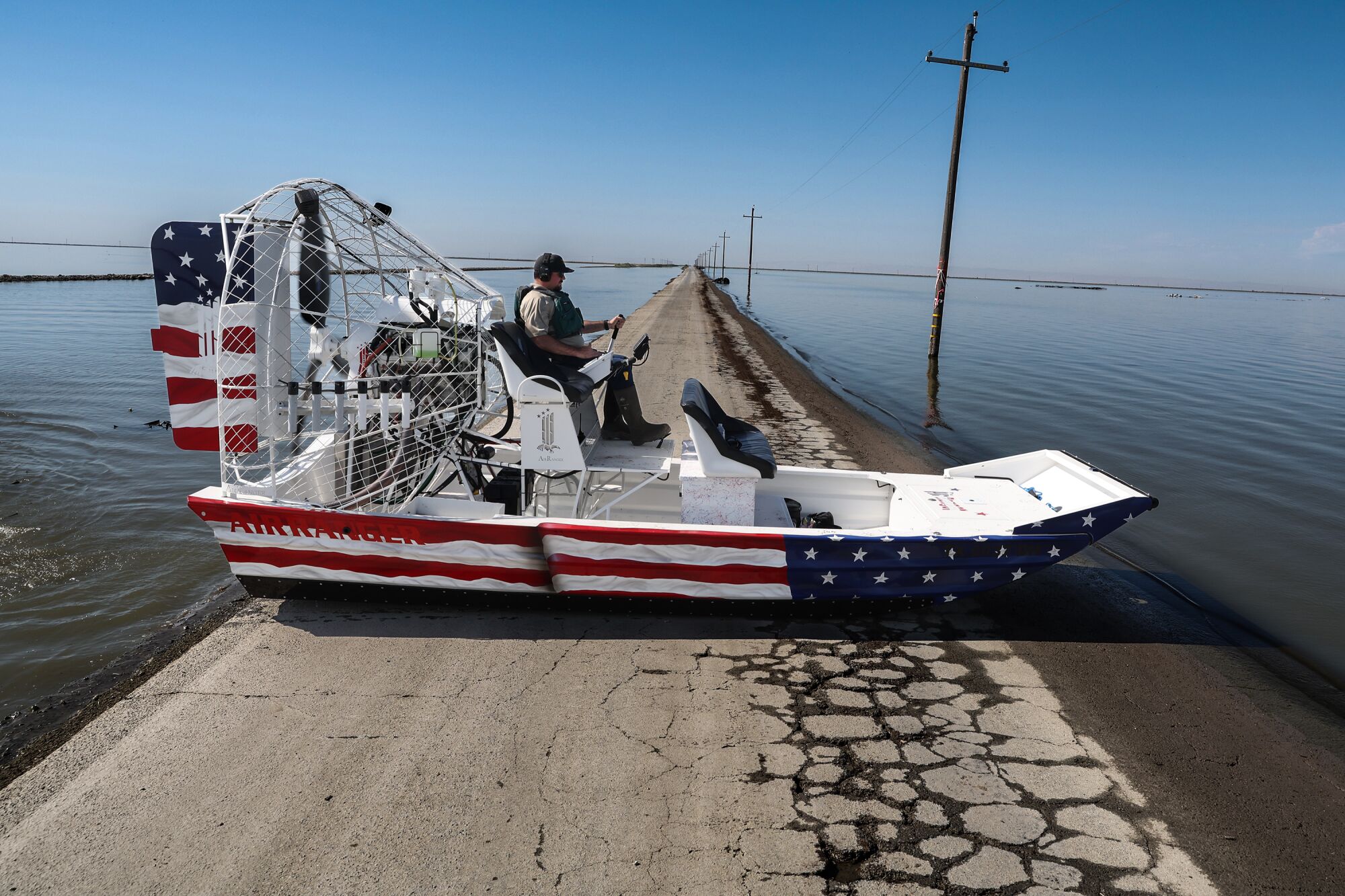Out on the water, a silence hangs in the air and the sun’s harsh glare reflects off the lake’s still surface. Small fish float belly-up alongside snakelike tubes of irrigation piping. Five feet below, abandoned chicken coops, dairy barns and equipment sheds slowly rot, their shapes blurred in the murky green water.
The Central Valley summer heat is unrelenting, even while boating across this ghost lake. It roared to life last spring after epic winter storms and runoff from the snow-laden Sierra Nevada overwhelmed the human-made systems that long ago drained the Tulare Lake basin. The reborn Tulare Lake submerged thousands of acres of farmland used to grow pistachios, almonds, cotton and safflower in one of the nation’s most productive agricultural regions, creating a seemingly endless blue horizon. But with little breeze and a wispy veil of high-flying clouds, the lake hardly offers the cooling reprieve afforded by its closest comparison, Lake Tahoe, the state’s eternal playground.
Even so, with Tulare Lake’s return, ducks, egrets and other waterfowl have flocked en masse to its dusty shores. Frogs wade on the water’s edge, diving in at the slightest movement. Tule grass sprouts along the shoreline. As Tulare Lake reclaims its historic footprint in the lowlands of the San Joaquin Valley, long-forgotten ecosystems have been revived.

Ducks, egrets and other waterfowl have flocked to the dusty shores of a reborn Tulare Lake.
(Robert Gauthier / Los Angeles Times)
The Times took a tour with the Kings County Sheriff’s Office, which purchased an airboat this summer for the purpose of patrolling the reborn lake.
“When this lake obviously appeared, it just added a whole new dimension to what we needed to be able to accomplish,” said Sheriff’s Sgt. Nate Ferrier, standing on the lake’s southeast shore near Corcoran. Even months after Tulare Lake’s reemergence, he remains in awe of its size and presence. “I’ve driven up and down all these roads and dirt roads and levees, and to see this much water covering all this farmland, it’s … kind of like a biblical moment.”
While the sheriff’s office has boats deputies use to cut across the nearby Kings River, they needed something with a flat bottom because of all the junk floating in the lake, Ferrier said. A normal boat with propellers would likely get stuck, he said, so they purchased the airboat for about $95,000 and trained five deputies how to operate it.

King’s County Sheriff Sgt. Nate Ferrier looks over flooded broiler houses, passing sheds on a flooded Foster Farms chicken ranch.
(Robert Gauthier / Los Angeles Times)
The lake flooded private land, so technically, wading or boating into the waters is a form of trespassing. The shoreline is peppered with “Private Property” signs featuring a big, red hand warning against hunting, fishing or trespassing. But in some ways, what looms below the surface is a bigger concern. The floodwaters swallowed up storage sheds stocking fertilizer and other chemicals, along with manure piles, electrical wires and sharp-edged farm machinery.
Deputies have not had to deal with people trying to get boats out on the water to date, Ferrier said. But it hasn’t stopped people from getting close. In August, deputies came across an abandoned, half-submerged silver Nissan sedan that wasn’t there before. In other instances, they’ve found people fishing — and warned them it’s unclear whether it’s even safe to eat the fish.
“Word’s gotten out that water is pretty dirty, so it’s just not safe to be in. And most people don’t want to be in dirty water,” he said. “I wouldn’t recommend eating the fish just because of the amount of contaminants, and we don’t even really know what all is in there, honestly. So it’s just not worth the risk.”
Still, they needed to learn how to live with the lake, he said.

As Tulare Lake recedes, remnants of the agricultural life it brought to a halt are reemerging. At this flooded Foster Farms ranch, mildew cuts dark lines across the exterior of buildings where some chickens drowned.
(Robert Gauthier / Los Angeles Times)

A dead fish floats belly-up in the murky water of Tulare Lake. Sheriff’s Sgt. Nate Ferrier warns against eating the fish due to possible contaminants in the water.
(Robert Gauthier / Los Angeles Times)
Already, it is shrinking. Once 120,000 acres, roughly the size of Lake Tahoe, Tulare Lake had receded to 61,000 acres as of early August, Ferrier said. At its highest, the lake’s depth averaged between 5 and 7 feet.
As snowmelt streamed into the basin in spring, Tulare Lake’s rising waters threatened to inundate the city of Corcoran and its massive prison complex, as well as the farm communities of Stratford, Allensworth and Alpaugh. State water officials bolstered local efforts to head off disaster, diverting more than 20 billion gallons of water upstream from the rivers flowing into Tulare Basin. In late June, with the Sierra snowmelt slowing, the state declared success, saying Tulare Lake was in retreat.
As the water recedes, remnants of the agricultural life it brought to a halt are slowly reemerging. On a Foster Farms ranch that had housed more than a million chickens, mildew cut dark lines across the exterior of buildings where some chickens had drowned in their coops. Some of the barns were barely standing, stripped to their wooden beams by the water.
The ranch also housed workers, who lost their rental homes and belongings in the flooding. Here and there, a car roof was visible. Roads that had been swallowed were slowly reappearing, the asphalt gutted and cracked. Utility poles poked up in neat rows, hinting at the roads they once framed.
Near the chicken sheds, the stench of manure was strong. Signs declaring the farmland a “biosecure area” remained upright.

Tulare Lake’s resurgence swallowed up storage sheds stocking fertilizer and other chemicals, along with manure piles, electrical wires and sharp-edged farm machinery.
(Robert Gauthier / Los Angeles Times)
Gliding across the lake’s surface in the airboat, these signs of what used to be merged awkwardly with the signs of new life. Egrets made nests among the uppermost branches of drowning nut trees. Mallards paddled by, diving headfirst into the water as they searched for food. Yellow butterflies flitted above the water.
Jason Coslovich, a biologist with the California Waterfowl Association, said the lake is an ideal spot for the egrets that have claimed the orchard treetops.
“It’s definitely a big win for waterfowl,” he said, “all types of different birds and wildlife.”
What exactly is in the water, as far as pesticides, chemicals and bacteria, remains somewhat of a mystery, said Rose Mary Rahn, director of the Kings County Department of Public Health. The department has been testing the surface water, and the latest July results identified high levels of coliform and E. coli bacteria, which is typical in floodwater.
“There’s nothing unexpected,” Rahn said, but added, “We don’t really know everything that was on those properties.”

Out on the water, a silence hangs above Tulare Lake and the sun reflects off its still surface across a vast horizon.
(Robert Gauthier / Los Angeles Times)

To patrol Tulare Lake, the Kings County Sheriff’s Office needed a flat-bottomed boat, because of all the junk floating in the lake. The department purchased the airboat and trained five deputies how to operate it. Above, Sheriff deputy James Coghlan pilots an airboat across 10th Ave.
(Robert Gauthier / Los Angeles Times)
While the lake is not considered toxic, the department is discouraging people from entering the water or washing their hands in it because of the known and unknown contaminants, she said. It would be like dipping “a hand in a toilet bowl,” she said.
Patrick Pulupa, executive director of the Central Valley Regional Water Quality Control Board, said the agency was treating the lake as a “stormwater retention basin on somebody’s property.”
“Tulare Lake is really just kind of one of these interesting dynamics out there, where it doesn’t neatly fit in a box of how we regulate water in California, or frankly, in the United States,” Pulupa said. It’s unusual, he admitted, because of the lake’s sporadic occurrence.
Pulupa said the agency is not concerned with the lake’s contaminants. “The flood flow is so high that the water is just diluting it out,” he said of the concentration of nitrates.
But some other water experts expressed concern about how the lake water will affect groundwater supplies in surrounding communities. Michael Claiborne, directing attorney for the Leadership Counsel for Justice and Accountability, said the group’s primary worry is whether nitrates from the flooded dairy farms will bleed into groundwater basins used for drinking water. He said nearby communities such as Allensworth regularly test their water to ensure it is safe.

Dead and dying pistachio trees remain on a Hanson Farms ranch.
(Robert Gauthier/Los Angeles Times)
The last time the lake returned in a substantial way was 1983, when it survived for two years before disappearing again. And local officials say it could once again be years before this newest version of the lake fully recedes.
For the Kings County Sheriff’s Office, that means lake patrol is now part of the job. The airboat is here to stay, at least for the foreseeable future.
Stay connected with us on social media platform for instant update click here to join our Twitter, & Facebook
We are now on Telegram. Click here to join our channel (@TechiUpdate) and stay updated with the latest Technology headlines.
For all the latest Fashion News Click Here
